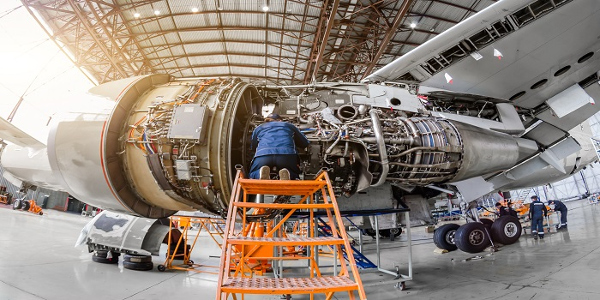In its bid to encourage air service operators to carry out aircraft maintenance activities within the country, the Ministry of Civil Aviation (MoCA) in September announced a new policy, which includes leasing of land through open tenders and abolishing royalty charged by the Airport Authority of India (AAI) for the Maintenance Repair and Overhaul (MRO) business. Besides, as per the policy announced by civil aviation minister Jyotiraditya Scindia, land allotment for entities setting up MRO facilities will be for a period of 30 years from the current three to five years as the government aims to make India a “global MRO hub.”
Industry experts said the new policy will not only aid in the growth of domestic aviation industry but could also spur export of MRO services outside India, especially in South-East Asia.
At present, air service operators send their aircraft for maintenance to foreign countries – mainly to the Middle East and the South-East Asian region – as it is less expensive than the domestic market.
Available market reports peg the Indian MRO industry (excluding defence) to be worth USD 2 billion annually, with domestic players barely handling 16% of the total business. The remaining 85% or almost USD 1.7 billion, especially in the area of components and engines, is currently done abroad.
Early last year, the Centre reduced the goods and services tax (GST) rate on aircraft repair and maintenance work to 5% from 18% and announced that it will lease out airports’ land to repair units at discounted rates to attract investment and boost growth.
“AAI is trying to facilitate the development of MRO industry in the country, in line with MoCA’s positive steps to stimulate the industry through National Civil Aviation Policy 2016 and in-sync with the prime minister’s campaign of creating an Aatmanirbhar Bharat,” an AAI spokesperson said.
The spokesperson added that tenders for setting up of MRO facilities at five AAI-run airports –Chennai, Begumpet, Chandigarh, Bhopal and Juhu – are in the “final stages”.
Within MRO services, there are four main segments – airframe maintenance, engine maintenance, components maintenance and daily and weekly checks (termed as line maintenance). Of these, engines and airframes account for about 50%-55% of the work by value, with engine and component airframe maintenance the most lucrative business within the segment.
Anand Bhaskar, managing director and chief executive officer at Air Works Group, which runs an independent MRO unit with facilities across locations, said the policy initiatives will boost investment in MRO sector and will also support the expected growth of the domestic aviation industry. Air works is the country’s largest private provider of line maintenance services (across 21 international airports) to foreign airlines flying into India.
As per the Oliver Wyman report released early this year, India’s air fleet is expected to grow more than double by 2030 and see significant growth in its MRO market.
“With the country’s aviation industry on a growth trajectory, it makes ample sense to capitalise this precious opportunity and expand the country’s aviation maintenance capabilities for greater self-reliance, job creation and to scale up the value chain, instead of just concentrating on airframes, which most Indian MROs currently do,” added Bhaskar.
Just prior to the Covid-19 pandemic, the now-privatised Air India’s engineering arm, Air India Engineering Services Ltd (AIESL), had signed a memorandum of understanding (MoU) with Pratt & Whitney to launch a joint engine MRO facility in Mumbai. At present, the airframe MROs in India caters to overseas customers owing to the requisite infrastructure.
“MRO industry will have to invest substantially in infrastructure to meet the challenges of fleet growth in both commercial and business aviation. With the new policy going to be implemented, we are looking to close these gaps over the next couple of years and ramp up to meet the demand of South Asia initially,” president of MRO Association of India and chairman of Max AeroSpace and Aviation Bharat Malkani said, adding that MRO Association expects exports of these services to take off by 2025 from India, attaining a value of USD 5 billion.
Delhi-based infrastructure group GMR, which runs an MRO facility from Shamshabad airport in Hyderabad, said reduction in GST rates has reduced the cost of MRO services within India for domestic airlines, and the new MRO policy will help strengthen domestic business and boost investment.
Industry experts believe that while overseas business is indeed attractive, Bhaskar said, “It is important that India also takes appropriate steps, not necessarily similar, to strengthen its indigenous aviation maintenance industry, on which all aircraft – regardless of type (commercial/business/defence) – depend.”
With the number of aircraft to be inducted into the fleet of Indian air operators expected to be twice its current strength over the next few years, Bhaskar estimated that the domestic MRO industry could well grow at a compounded annual growth rate (CAGR) of 10% or more, for the next few years.
“In order to make India an MRO hub, the focus is required on creating infrastructure and building technology for engines, landing gears and major components maintenance. Presently, most engines, landing gears and components are being sent out of the country for maintenance,” a GMR spokesperson said.
Source: HT
You may also like
-
Trade Connect E-platform For Exports Is Single Window, Fast, Accessible And Transformational: Shri Piyush Goyal
-
Dot Simplifies Approval Processes For Telecom Licenses And Wireless Equipment
-
Coal Production and Supply Trends on Positive Trajectory
-
Union Minister To Release Booklets On Promotion Of Indigenous Species & Conservation Of States Fishes
-
2nd India-Japan Finance Dialogue held in Tokyo on 6th September, 2024
